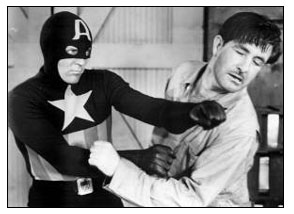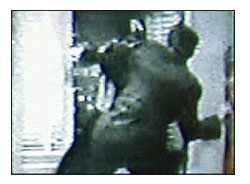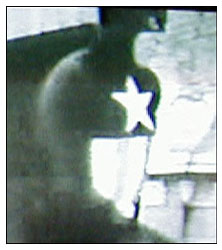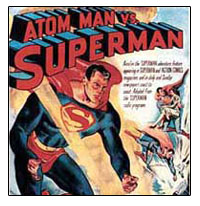|
Captain
America Gets Serial
(originally published in the Winter, 2004 issue
of Once Upon A Dime)
 I
was at a Comic Con in Los
Angeles and happened across a DVD of the 1944 Republic
serials of Captain America. It includes 15 chapters
totalling about four hours of glorious black and
white patriotic pugilism. Except this is not super-soldier
Steve Rogers. Instead Dick Purcell plays Grant Gardner
the District Attorney. Sure he suits up in a pretty
familiar red, white and blue spandex suit but there
are other differences. The mask has no wings at
the ears. This Cap never carries a shield. And for
the very picky; his red and white stripes are only
on the front not the back. His assistant Gail Richards
(Lorna Gray) knows his secret identity and calls
both Cap and Grant on his car radio with tips and
warnings. Although Cap rides a motorcycle in the
opening credits of each chapter in his actual adventures
he drives a run of the mill sedan. I
was at a Comic Con in Los
Angeles and happened across a DVD of the 1944 Republic
serials of Captain America. It includes 15 chapters
totalling about four hours of glorious black and
white patriotic pugilism. Except this is not super-soldier
Steve Rogers. Instead Dick Purcell plays Grant Gardner
the District Attorney. Sure he suits up in a pretty
familiar red, white and blue spandex suit but there
are other differences. The mask has no wings at
the ears. This Cap never carries a shield. And for
the very picky; his red and white stripes are only
on the front not the back. His assistant Gail Richards
(Lorna Gray) knows his secret identity and calls
both Cap and Grant on his car radio with tips and
warnings. Although Cap rides a motorcycle in the
opening credits of each chapter in his actual adventures
he drives a run of the mill sedan.
 The
most disturbing deviation from the comic book Captain
has to be that this Captain American uses a gun.
Several guns. Routinely. Very often Cap enters a
room with a pistol drawn. He explains later that
his first shot is alway a blank to serve as a warning.
And sure the bad guys typically swat the gun away
so we can get into the fisticuffs. None-the-less
the image of Cap shooting common thugs cold-dead,
while perhaps very 1940's, doesn't seem very...Captian
America. The
most disturbing deviation from the comic book Captain
has to be that this Captain American uses a gun.
Several guns. Routinely. Very often Cap enters a
room with a pistol drawn. He explains later that
his first shot is alway a blank to serve as a warning.
And sure the bad guys typically swat the gun away
so we can get into the fisticuffs. None-the-less
the image of Cap shooting common thugs cold-dead,
while perhaps very 1940's, doesn't seem very...Captian
America.
 In
the first of these serials Cap is on the trail of
The Scarab. The Scarab is basically a code name
since this villain dresses in ordinary street clothes
and possesses no super powers (beyond his intellect).
The Scarab has mastered a method of hypnosis and
is using it to obtain a powerful weapon called the
Dynamic Vibrator. (I'm not kidding.
If my memory serves the pretty Gail Richards actually
says "if that vibrator gets into the wrong
hands..." Ah the innocence of the golden age.) In
the first of these serials Cap is on the trail of
The Scarab. The Scarab is basically a code name
since this villain dresses in ordinary street clothes
and possesses no super powers (beyond his intellect).
The Scarab has mastered a method of hypnosis and
is using it to obtain a powerful weapon called the
Dynamic Vibrator. (I'm not kidding.
If my memory serves the pretty Gail Richards actually
says "if that vibrator gets into the wrong
hands..." Ah the innocence of the golden age.)
 Like
most serials each episode ends with a cliff hanger.
Cap or someone dear to him is about to meet their
end and...fade out. Each installment begins by replaying
the fight scene from the last chapter before adavncing
the plot. These monochromatic treasures were directed
by John English, also the director of the Captain
marvel serials, and Elmer Clifton. Like
most serials each episode ends with a cliff hanger.
Cap or someone dear to him is about to meet their
end and...fade out. Each installment begins by replaying
the fight scene from the last chapter before adavncing
the plot. These monochromatic treasures were directed
by John English, also the director of the Captain
marvel serials, and Elmer Clifton.
 The
series had no less than nine writers. And they give
Cap such straight faced dialogue as "It's curtains
for you!" Although to be fair maybe in 1944
that line was not yet a hackneyed cliche. Also a
seemingly tired plot point is actually (in a pre-Keanu
Reeves Speed world) pioneering. Cap finds out his
car has been tampered with when a motorcycle cop
pulls over to a roadside call box to break the news.
Cap must not reach a certain speed or else the car
will explode. The
series had no less than nine writers. And they give
Cap such straight faced dialogue as "It's curtains
for you!" Although to be fair maybe in 1944
that line was not yet a hackneyed cliche. Also a
seemingly tired plot point is actually (in a pre-Keanu
Reeves Speed world) pioneering. Cap finds out his
car has been tampered with when a motorcycle cop
pulls over to a roadside call box to break the news.
Cap must not reach a certain speed or else the car
will explode.
 The
series was the first of the Timely Comics heroes
on the silver screen. And he beat Superman to live-action
by four years. (Captain Marvel gets to stand as
the first live-action superhero -- his Republic
serial, also directed John English, debuted in 1941,
the same year as an animated Superman). The
series was the first of the Timely Comics heroes
on the silver screen. And he beat Superman to live-action
by four years. (Captain Marvel gets to stand as
the first live-action superhero -- his Republic
serial, also directed John English, debuted in 1941,
the same year as an animated Superman).
The Superman serials were more true
to their comic book roots for some reason. But I
suppose we need not worry too much about the depiction
of Cap and his crime fighting because the credits
clearly warn us that the characters and events are
fictional. Phew!
-- Daniel DeFabio

|